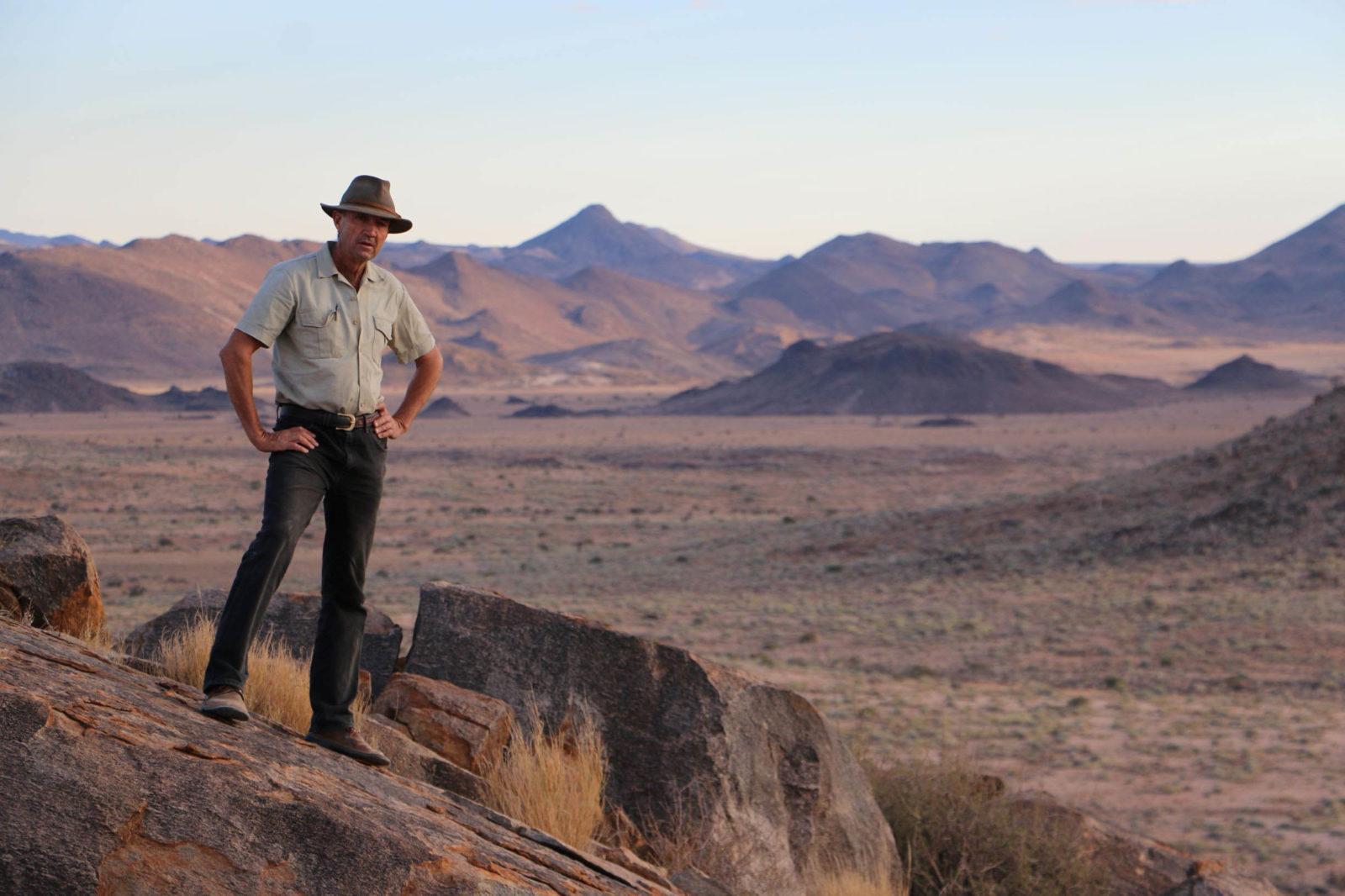
Dr Pete Morkel on his farm in southern Namibia. (Photo supplied)
By Gail C Thomson• 22 May 2020
From Namibia to Gabon, Chad, Angola and Niger, wildlife vet extraordinaire and conservation legend Dr Pete Morkel has left an indelible mark. Now he is fighting for his life in a battle with cancer. Friends and colleagues have launched a global fundraising campaign for his treatment. Gail C Thomson (formerly Potgieter) pays tribute to his remarkable career.
This is not an obituary. This is a tribute to a living conservation legend who is nonetheless fighting for his life. He has always been a fighter, though, long before cancer came knocking on his door. He has spent his life fighting for animals, particularly those that inhabit his beloved Africa. His name is Dr Pete Morkel.
This name is well known in conservation circles, but especially among wildlife veterinarians, where he is known as a pioneer. The conservation biologists who have worked with him have similarly recognised his abilities and have expressed deep gratitude for his help. While he is on a first-name basis with Prince Harry and received a lifetime achievement award from Prince William, Pete is relatively unknown to the general public. My purpose in writing this article is two-fold: to allow some of his co-workers to express their gratitude and to share some of their stories with those who may not be familiar with Pete’s work.
Pete is a pioneer wildlife veterinarian who has brought innovation and a new level of professionalism to his trade. Many of those who shared their stories with me (including several vets) consider him to be the best wildlife vet in Africa. According to Dr AK Kes Smith: “He was the only vet we trusted to immobilise the precious Northern White rhinos.” This effort included the very first efforts to save the remaining population in the wild, and bringing the last few of the species (including the famous male “Sudan”) from zoos to Ol Pejeta in Kenya.
Pete is especially known for his innovation, which is a result of his unquenchable thirst for knowledge and ability to think laterally. Who would have thought that airlifting a rhino upside down by its feet was a good idea? Pete did, and it is now known to be the safest way of airlifting these hefty creatures via helicopter. His work also includes helping develop new tracking devices for rhinos – transmitters in the horns last longer and are safer for rhinos than the old ankle bracelets; and giraffes – neck collars don’t work on them, so small devices are fitted to their ossicones (“horns”) instead. Dr Kes Smith (rhinos) and Dr Julian Fennessy (giraffes) both testify that Pete was closely involved in both developing and testing these new tracking methods that have since become standard practice.
One of the most important responsibilities a wildlife vet has is to ensure that the entire process of darting, capturing, moving and releasing an animal is as safe as possible. Pete is driven by such a fierce love for the animals that he works with that he will do absolutely anything, even at great risk to his own safety, to keep each animal safe. As noted by Jessica Groenendijk when she witnessed Pete doing everything in his power to persuade a newly translocated rhino to eat a different diet in a new environment: “It was clear to me that, for Pete, each rhino was an individual in its own right, with a unique personality.”
Indeed, his personal safety and comfort seem to be the last thing on his mind. He is known to abandon his shoes altogether when approaching a dangerous animal to dart it, despite the vicious thorns found throughout African savannahs. He approaches each lumbering elephant or rhino extremely closely before aiming his dart gun. Shoes make slightly more sound than bare feet, and by doing without them he could get closer before firing, which meant that his shot would be more accurate and he could get to the darted animal as soon as it was down. The choice between improving animal safety (even marginally) and tearing up the soles of his feet by running full tilt through thorny bushes is an easy one for Pete – the animal comes first!
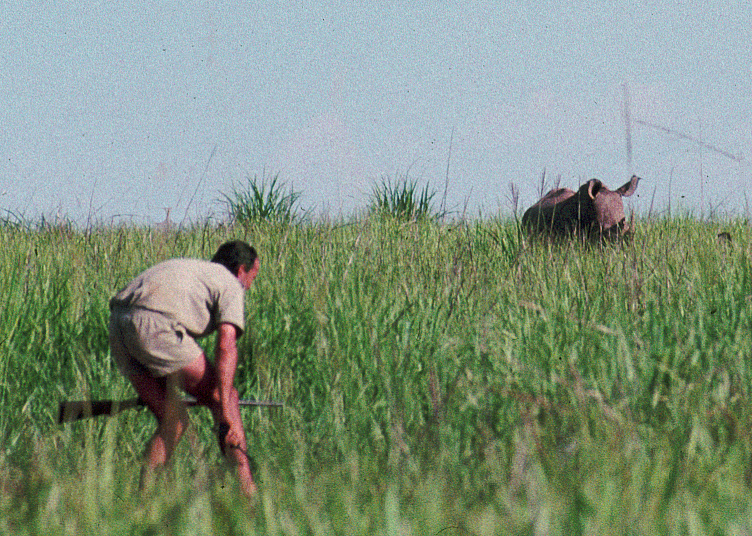
An early photo of Pete’s work with rhinos. He usually chose to stalk his quarry barefoot before darting.
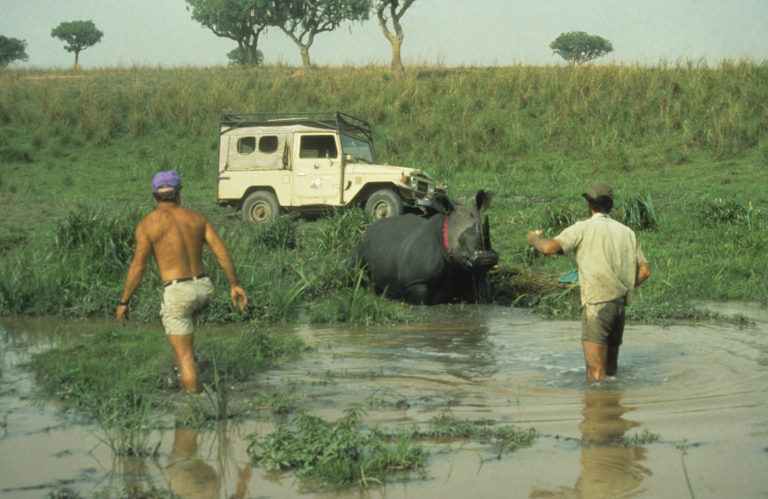
Before Pete helped develop transmitters to be implanted in horns, rhinos were either collared (pictured) or ankle bracelets were used – neither option was ideal.
Concerns about the safety of the animal do not stop after the initial darting. If the purpose of the operation is to translocate an animal from one place to another then the vet has to keep the animal in a state of semi-wakefulness throughout the transport phase. This is especially challenging for long-distance transportation, where the animal may be carried at different times by helicopter, truck and plane.
Dr Mark Jago, who has translocated many black rhinos himself, describes the procedure as a delicate “dance” between chemicals that wake the rhino up and put it to sleep. The aim is to keep a perfect balance between the two, so the rhino is awake but calm. This is especially tricky for black rhino, as Dr Jago explains:
“During movement, or translocation… it is said that the greatest threat to the black rhino is the black rhino. Cooped up in specially designed steel transportation crates, the explosive nature of the black rhino has the potential to result in serious damage to itself or even death as a result of its vain attempts to escape from confinement.” He learned from Pete how to choreograph this “dance” to perfection.
In such a delicate operation, there is always a chance that things can go wrong. And when they do, one needs nerves of steel and incredibly quick thinking to prevent the loss of life – human or animal. In one instance that Dr Jago recalls, Pete injected a rhino that was sleeping too deeply with a drug to make it slightly more awake. Little did he know that the syringe he used had previously contained another drug – one that wakes a rhino up 100%! What happened next, in Dr Jago’s words:
“Within less than 30 seconds the gargantuan colossus lumbers to his feet and stares at us from only a few metres away. Pete stands between us and certain chaos. He returns the rhino’s stare with equal menace and conviction. The moment hangs in the balance. Slowly, very slowly, the rhino turns and walks away. Pete looks into the distance deep in thought, and then without moving his feet he gradually and deliberately looks over his shoulder uttering the memorable words, ‘Gentlemen, that is how not to do it’.”
In the days before this chemical “dance” was as well refined as it is now, and before rhino translocations had a big enough budget to hire aircraft for the purpose, Pete was moving rhinos on transcontinental flights – a crazy endeavour at the time. In one case, he had to transport a female rhino from Addo Elephant National Park in South Africa to Port Lympne Wild Animal Park in the UK (in the last few years, he has spearheaded a project called “Back to Africa” to release the progeny of some European zoo rhinos back into the wild). Keeping a rhino calm during a long flight is one thing, but because this flight was not chartered for the purpose, it carried other cargo (including frozen fish) and had to make several stops along the way.
Pete came prepared for this arduous journey – with plenty of oranges. Each time he fed “Vuyu” the rhino an orange, she would go into a zombie-like state of total satisfaction, until she came back to earth and demanded another one. As he was one of the only witnesses to this amazing journey, here is some of it in his own words:
“Our first stop was Kinshasa. We had to reorganise all the pallets on the plane and this meant off-loading Vuyu onto the apron and keeping her there for about 30 minutes while they shuffled things around. Although there was a lot of aircraft movement, noise and strong lights, she was a sweetie-pie – as long as she had oranges! When it came time to put her back in the aircraft the hydraulic scissor lift was unable to get her pallet up to the level of the cargo door. We finally found another lift that did the job and off we went.
“Due to the delay, it was pretty obvious we were not going to make it with the oranges – and Vuyu without oranges was not the happiest rhino! After a quick stop in Lagos, our next one was going to be Vitoria in Spain, so I asked the pilot if he could radio ahead and get the people there to have plenty of oranges ready for us for when we arrived. When we got to Vitoria there were heaps of delicious Spanish oranges ready for spoilt Miss Vuyu – so needless to say she was happy all the way to the UK!”
Wildlife veterinary work isn’t just about handling animals, however, and many of Pete’s admirers were impressed most by the way he handles the less glamorous parts of the job. He has worked in countries that are politically unstable and where basic facilities and infrastructure were non-existent, yet some of Africa’s most endangered animals inhabit these countries and are therefore in dire need of conservation.
Dr Hubert Planton, who worked hard in the 1990s to save the now-extinct Western Black rhino, recalls the working conditions he and Pete endured in their three-week expedition in Cameroon during 1996:
“It was the onset of the rainy season, which means: no road, no defined trails; we had to do everything on foot, and there were no bridges to cross the streams/rivers. Daily temperatures reached 40°C with 100% humidity just before the heavy storms hit, which happened every day. For lunch, we shared stale bread and a can of sardines, plus a few dried bananas. Every evening we cooked couscous and added another can of sardines. We slept every night on the concrete floor, without a mattress, just under a mosquito net. Pete never complained, never.”
In Chad, Pete worked tirelessly to collar 70 elephants, darting each one on foot (as opposed to from a helicopter) under hot, difficult circumstances, without losing a single animal. Dr Dolmia Malachie, who worked with him on this mission, relates his experience:
“The first thing Pete impresses me with is his endurance. He likes to track elephants every day, regardless of weather conditions: hot or cold, wet or dry, day or night. We had to wake up early each morning and drive a little way before walking the rest of the way to find the elephants we were tracking. Pete then got into his rhythm: military-style, taking giant strides through the bush, he would hardly eat or drink for days at a time. Pete is no less than 20 years my senior, but I had to run to keep up with him!”
Perhaps the most dangerous work he has undertaken is darting forest elephants in Central and West African countries. These elephants are under severe poaching pressure and are thus known to be more aggressive than most savannah elephant populations. Furthermore, working in the confines of a rainforest means that visibility is highly limited and one can walk almost straight into an elephant if you’re not careful. As Dr Tobias Graessle, who worked in the Dzanga-Sangha rainforest in Central African Republic with Pete, recalls, “At times I was afraid my heart would escape my chest, pounding like a jackhammer.” While extremely dangerous, this work is immensely valuable, as little is known about this species of elephant, which is nonetheless even more threatened than its better-known savannah cousin.
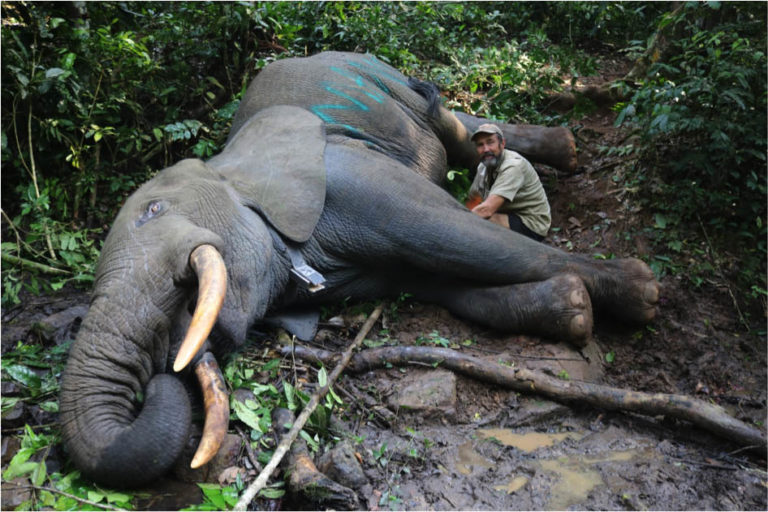
Darting and collaring forest elephants has to be done on foot in extremely challenging and often dangerous circumstances. (Photo: Tobias Graessle)
Because he is willing to go places and do fieldwork that most would baulk at, Pete has had a hand in conserving, researching and managing animals that few people have ever seen. From giant sable in Angola and giant eland in Chad to forest elephants in Gabon and West African giraffe in Niger, he has overcome the odds posed by extreme environmental conditions and proved to others that nothing is impossible.
Part of what makes his work so successful is his ability to improvise and come up with solutions to the major challenges posed in each situation. This is what Dr Julian Fennessy fondly terms “Morkelling: the act of fixing or building/adapting something in the field – like MacGyver”. Considering that Fennessy specialises in the research and conservation of one of the most difficult animals in Africa for a vet to immobilise – the giraffe – he knows what he’s talking about! He and Pete have worked together in west, east and southern Africa on all of the giraffe subspecies and under every conceivable circumstance. Pete’s methods of capturing and translocating giraffe have thus become “best practice” for working with this tricky species.
Translocating animals is about so much more than just darting, loading and unloading. It is a complex operation that requires teams of people all working together for the same goal. Each operation comes with its own challenges, which allows Pete to showcase his out-of-the-box thinking. Dr Marketa Antoninova, who worked with him on many such projects in various countries recalls:
“He never hesitated to follow the most insane proposition to satisfy our operational needs, while always keeping the animal’s well-being in first place. He brought a simple and realistic approach to any conservation operation in which he participated.”
While many vets are good at working with animals, Pete is also exceptionally good at working with teams of people, a skill that has become a hallmark of his career. As expressed by Dr Antoninova:
“He was always willing to share knowledge gained from his vast experience and put other people together to share. That is a very rare phenomenon in conservation, especially in the current era where data are overly protected.”
As a result, Pete has helped build game capture teams from scratch and has contributed immensely to those in South Africa, Namibia and Uganda, among others. He has been integral to the many successful large-scale reintroduction efforts by African Parks in countries such as Chad, Malawi, Rwanda, Central African Republic, and the Democratic Republic of Congo.
Moving beyond game capture, Pete has been instrumental in broader conservation projects like Dr Pedro Vaz Pinto’s award-winning work on giant sable in Angola. Dr Vaz Pinto credits Pete for going far beyond his role as a vet:
“Pete selflessly assumed a crucial advisory role on many aspects of the giant sable programme – he created a network of relevant and usually the best people to assist the project. He even used his personal influence to expose our work to potential donors and actively assisted us with fundraising. It is no exaggeration to say that the results obtained on the giant sable project, which has so far succeeded in rescuing this amazing species from the brink of extinction in spectacular fashion, would hardly have been possible without Pete.”
Building a good team that can carry out large-scale operations requires a certain kind of leader. Pete intuitively recognises talented, dedicated young people and then mentors to become the professionals he knew they could be when he first saw them. Numerous young vets, field biologists, rangers and conservation managers credit Pete for giving their careers a vital boost through his direct training and his general influence as a mentor.
In the words of Jean Labuschagne and Erik Mararv: “Pete loves passionate and hardworking individuals, especially youngsters, and always goes out of his way to help give them experiences and boost their confidence in whatever it is they are doing.”
One of his early mentees, Cathy Dreyer, first met Pete in 1999 when she was fresh out of university and had very little field experience. At that time, Pete was the head of the SANParks Game Capture Unit in Kimberley, South Africa. She recalls:
“Pete introduced me to my first black rhino and from that day on my life was never the same. I not only learned everything I know about black rhino from Pete, but learnt the art of boma training these animals and preparing them for journeys all over Africa.” Since then, she has been appointed as conservation manager for Addo Elephant National Park in South Africa and has won the Tusk Trust Award for Conservation in Africa.
Many young vets and researchers met him while attending the internationally acclaimed “Course on Chemical and Physical Restraint of African Wildlife” in Zimbabwe, where he and other experienced vets taught them both the theory and practice of game capture for a wide array of species. One of these, Dr Anna Haw, suggests that Pete’s training went beyond technical know-how:
“I knew that I wanted to be a vet like Pete, and stick to my values and principles. Pete’s example gave me the courage to turn down lucrative private wildlife vet jobs that went against my conservation values. I cannot be more grateful for following his excellent example.”
At his suggestion, she went on to complete a PhD focusing on rhino immobilisation and has thus contributed to further improvements in this field – a contribution after Pete’s own heart.
Dr Amanda Salb is another young vet whose career and work in Malawi has greatly benefitted from Pete’s mentorship. In her words:
“Pete was really one of the biggest mentors in my career here and his foresight has helped us so much in Malawi. Every time he was here, he let me tag along with him and learn from him.” In common with many others, Salb knew that Pete was always just a phone call away and would willingly offer his advice, day or night:
“I remember darting my first elephant, which was caught in a snare. I called him at 6am for help and he answered the phone and was critical to the success of that snare removal.”
Another young vet from Uganda, Dr Robert Aruho, jumped at the chance to express his gratitude to Pete, echoing the sentiments of many others:
“Pete has inspired courage and patience to look after wildlife in a way no one else I know has ever shown. He has taught me wildlife veterinary practice like a father teaching a son. For this I am very grateful. Despite our age differences, I consider him a friend. He is selfless and will do anything in his power to save a wild animal from distress.”
Besides assisting other vets, Pete has interacted with many conservation researchers in the early stages of their careers. Among these is PhD candidate Emma Hart, who witnessed first-hand Pete’s renowned giraffe-capturing skills during her research in north-western Namibia. She recalls:
“In 2016 Pete taught me to shoot a gun, drive a 4×4 vehicle and rope a wild giraffe in the Namib Desert. Pete has the rare ability to both believe in and nurture the best from those he meets. During my first months in the Namibian conservation scene, as well as teaching me countless field skills, he took the time to personally introduce me to a network of invaluable contacts.”
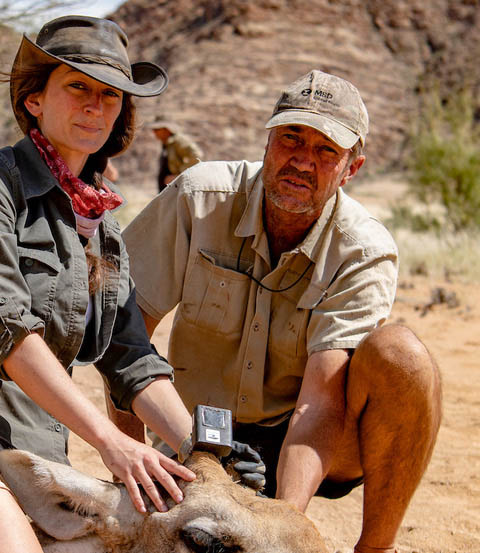
Emma Hart and Dr Pete Morkel after fitting an ‘ossi-unit’ to a giraffe for tracking purposes. (Photo: Amy Vitali)

Capturing giraffes requires practice and teamwork – Pete is the ‘giraffe’ in this exercise. (Photo: Randal Hinz)
Dr Colleen Begg, now a well-known carnivore conservationist working in Mozambique, was also fortunate enough to work with Pete while still a PhD student herself. With her husband, Keith, Dr Begg did some ground-breaking work on honey badgers in the South African Kalahari Gemsbok National Park during 1996-99. Keith recalls:
“Pete was very important in helping us get SANParks permission that allowed Colleen and I to track, immobilise and radio collar honey badgers”.
They realised early on that collars didn’t work on their feisty study subject, so Pete and other vets were brought in to surgically implant radio transmitters under the badger’s skin. This allowed them to observe the secret life of a honey badger, which led to a greater scientific understanding of the species, a multi-award winning National Geographic documentary called Snake Killers, and the now-viral videos on the theme “Honey badger don’t care” that have attracted over 90 million views.
This is just the just a small selection of the work Dr Pete Morkel has done over the years. If this sounds to you like an incredibly fast-paced, hectic career, then you are right. For most conservation researchers and park managers, darting and translocating animals is a time of high-paced stress that only comes around every few months or even years. The rest of the time one can get back to normal-paced, less stressful tasks. For Pete, this was life. From weeks of arduous trekking through the bush in Chad to dart elephants, to multi-day transcontinental flights with precious rhino on board, to running for his life from forest elephants in central Africa, Pete was almost continuously on the go. Indeed, he and Dr Fennessy were just about to embark on another West African giraffe translocation project in Niger when Pete was forced to slow down his breakneck pace in January this year.
His cancer diagnosis came as a shock to all, particularly the doctor’s prognosis that it would be extremely difficult to treat using radiation or chemotherapy. Thankfully, Pete has a wonderful, close-knit family and a huge network of friends who are there for him in this time of difficulty. Throughout his storied career, Pete’s wife Estelle has been his rock – no matter how far or for how long he had to be away from home, she was always there for him, just a phone call away. His colleagues and friends have always recognised Estelle as the heartbeat of this seeming superhero. Furthermore, his two children Chéri and Benoit have most certainly made him proud by enhancing the Morkel name even further through their own conservation careers.
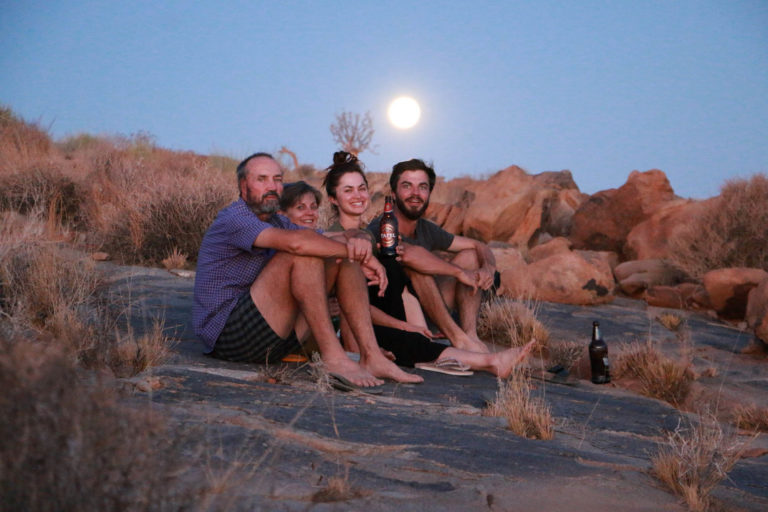
The Morkel family – Pete, Estelle, Chéri and Benoit. (Photo supplied)
Given the rather bleak prognosis for conventional cancer treatment, a medical doctor close to Pete has suggested that he try immunotherapy. This treatment is extremely expensive, so a group of Pete’s close friends – Mike Kock, Hugo van der Westhuizen and Rick Clark – launched a GoFundMe campaign to cover the costs, knowing that the expense was way beyond the family’s financial means. The speed with which this campaign reached its initial $100,000 target is a testament to the number of lives Pete has touched both personally and professionally. While this covers the treatment, there will be many more expenses to cover, so the target has been raised by $50,000 for this purpose.
If it were up to Pete, every cent of the funds raised to help pay for his cancer treatment would go to conservation instead. He’s just that kind of man. Thankfully, his circle of family, friends and colleagues recognise that the value of his personal contribution to conservation over the years utterly dwarfs the amount he needs for treatment. Considering all that he has sacrificed over the years, our contributions are just a small “thank you” for his priceless work.
For more about Dr Pete Morkel’s life work and dedication to conservation, his biography, written by his brother, Michael, can be purchased here.
Gail C Thomson (formerly Potgieter) runs an independent company in Namibia called Felines Communication and Conservation. She has active contracts with the Namibian Chamber of Environment and World Wildlife Fund, South Africa. She has never received funding from hunting organisations.


